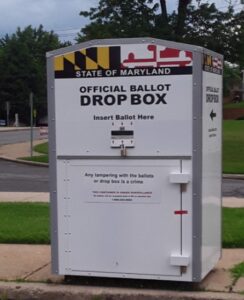Outlook of 2022 Maryland State Senate Races

| STRONG R | STEADY R | SLIGHT R | 50/50 | SLIGHT D | STEADY D | STRONG D |
|---|---|---|---|---|---|---|
| Open-R-1 | Corderman-R-2 | Open R-34 | Hester D-9 | Klausmeier D-8 | Open D-3 | Open D-10 |
| Open-R-5 | Open-R-4 | Elfreth D-30 | Jackson D-27 | Lam D-12 | Hettleman D-11 | |
| Jennings-R-7 | Salling R-6 | Open R-33 | Beidle D-32 | Guzzone D-13 | ||
| Bailey R-29 | Open R-37 | Zucker D-14 | ||||
| Simonaire R-31 | Carozza R-38 | Feldman D-15 | ||||
| Gallion R-35 | Lee D-16 | |||||
| Hershey R-36 | Kegan D-17 | |||||
| West R-42 | Waldstricher D-18 | |||||
| Kramer D-19 | ||||||
| Smith D-20 | ||||||
| Rosapepe D-21 | ||||||
| Pinsky D-22 | ||||||
| Watson D-23 | ||||||
| Benson D-24 | ||||||
| Griffth D-25 | ||||||
| Open D-26 | ||||||
| Ellis D-28 | ||||||
| King D-39 | ||||||
| Hayes D-40 | ||||||
| Carter D-41 | ||||||
| Washington D-43 | ||||||
| Sydnor D-44 | ||||||
| McCray D-45 | ||||||
| Ferguson D-46 | ||||||
| Augustine D-47 | ||||||
These projections based solely on primary turnout. I took all of the votes each Democrat candidate (or candidates and combined the total) and compared that to the amount of votes each Republican candidate or candidates received.
In most districts, there are more registered Democratic voters than Republicans but more Democrats are likely to switch over to vote Republican.
Here is a breakdown on how the chart was created:
Strong Republican– Republican primary candidates received double the amount of votes of Democratic candidates
Steady Republican– Republican candidates received significant more votes than Democrats but it didn’t double the votes.
Slight Republican– Republican candidates in their primary have a few hundred more or a few hundred votes less than the all the Democratic votes in their primary.
Toss Up. The Democratic candidates had more votes than the Republican candidates but the total didn’t double.
Slight Democrat– The number of votes casted for Democrat candidates doubled the amount of votes casted for Republican candidates, but the amount did not triple.
Steady Democrat- The number of votes casted for Democrat candidates tripled the amount of votes casted for Republican candidates, but the amount did not quadruple.
Strong Democrat– All Democratic candidates received at least four times and beyond the amount of primary votes as all the Republican candidates in a Senatorial District.
Again this chart is based on raw numbers. It doesn’t take into account incumbency, campaign finance reports and doesn’t factor areas that might have more conservative Democrats.
For example, Bill Folden and his Republican opponent combined for 12,500 votes in District 4.
The Democratic Senatorial candidate in District 4 received 8,500 votes. The Republican vote did not double the Democratic vote so this race is only listed as “Steady Republican” but this race is probably closer to “Strong Republican”.
Some numbers are on the borderline too. In District 3, the two Democratic candidates received a total of 11,455 votes and GOP candidate Angela Ariel McIntosh received 4,193 votes. That Democratic total doubled her number of votes but it didn’t triple. However, it came close (4193 x 3 = 12,579). So technically, this race falls under “Slight Democrat”, but is closer to “Steady Democrat”.
What I learned
Of course the new Democratic map, which was not approved by Gov. Hogan or any Republican members of the Maryland General Assembly, is gerrymandered. Many of the “battleground” races of 2018 are now tougher for Republicans.
An example is District 8. There were four voting precincts where Republican Christian Miele defeated Klausmeier by a combined 800 votes. Those precincts are out of the district. Four new precincts (2 from District 42, 1 from District 6 and 1 from District 7) were added. In 2018, the Democratic Senatorial candidates combined for 1,200 more votes than the Republican candidates. That would have gave the Democrats a net gain of 2,000 votes in 2018 with this new map
It shows too as Klausmeier and her Democratic primary opponent combined for 10,432 votes.
Republican Ken Fitch received 3,598 votes. The Democrats nearly tripled that total but fell short so the race is “Slight Democrat”. Still far from the toss-up race in 2018.
It appears similar gerrymandering took place in District 9. Former Republican Sen. Gail Bates was upset by her Democratic challenger Katie Fry Hester in 2018. Republican challenger Reid Novotny would be easily be favored against Hester in 2022 in the old district but the new district makes this a toss-up. Novotny can and should still win, but it will be a much tougher battle.
District 33 could be a concern for Republicans in 2026. Democrat Heather Bagnell was able to sneak into the third seat for delegate in District 33 and now the district is gerrymandered for Democrats. I think Republican Del. Sid Saab will retain retired Sen. Ed Reilly’s old seat this year, but it could be in trouble if there is a blue wave again in 2026. That is why this is the only Republican Senate seat that is listed as “toss-up”
The same could be said in District 34 when the Democrats won both delegate seats in District 34A in 2018. Republicans should sweep all the delegate seats and Christian Miele should retain Bob Cassilly’s Senate seat in 2022, but who knows in 2026.
There is some good news as District 30 is very winnable for Republican challenger Stacie MacDonald in that Senate race. District 30 around Annapolis is a very moderate district and Republicans Herb McMillan and Ron George served as delegates in the district. The late Speaker Michael Busch and former Sen. John Astle were considered “old school” Democrats. Sen. Sarah Elfreth and the two Democratic delegates in District 30A are liberal Democrats in a moderate to conservative district. When you add Seth Howard’s strong single-member District 30B, MacDonald has an excellent opportunity to flip this seat red.
One district in play is District 32 in northern Anne Arundel County. I guess when Democrats gerrymandered District 33, they took away some Democratic votes from District 32. The primary turnout Democrat vs. Republican was very more favorable for Republicans than previous years. I don’t know anything about the GOP Senatorial nominee Kimberly Ann June, but Pamela Beidle’s seat could be in play.
Send all political news to news@redfreestate.com.









7 thoughts on “Outlook of 2022 Maryland State Senate Races”